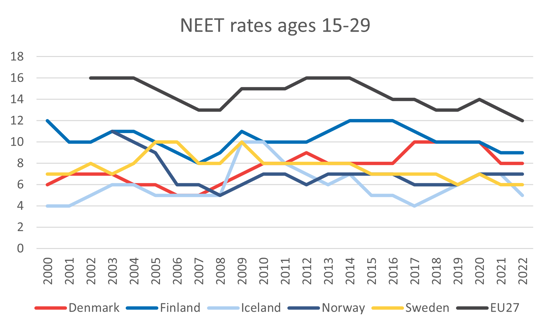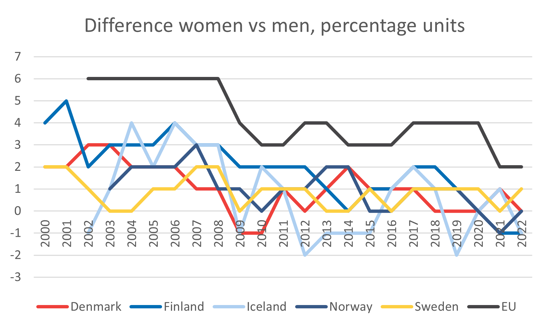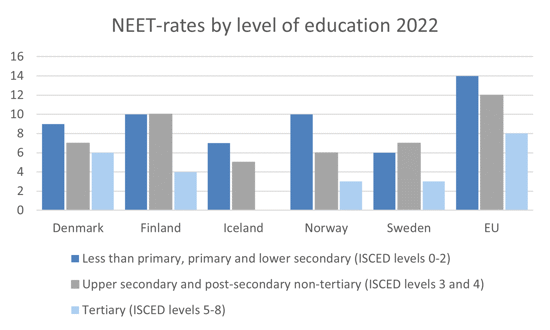Nordic NEET rates on EU target levels
The European Union has set an EU-level target stipulating that the share of young people, aged 15-29, neither in employment nor in education or training should be less than 9 percent by 2030. Four of five Nordic countries participating in the European Labour Force Survey (LFS) met this target in 2022, and the fifth is not far off.
Today young people are changing jobs more frequently and it takes longer to get established on the labour market. Therefore, it is important to make sure that the transition from education to work is smooth and to highlight the risks associated with being neither in employment nor in education or training. There are risks, both for the individual and in the long run for society, if young adults find themselves disengaged from both education and the labour market. (1)
In the European Pillar of Social Rights Action Plan (2), a stated goal is that the proportion of 15–29-year-olds neither in employment nor in education and training (NEET rate (3)) should be below 9 percent in the EU by 2030. In 2022, an average of 12 percent was identified as NEET within EU. The rate ranged from 4 percent in the Netherlands to 20 percent in Romania. (1)
Among the five Nordic countries that participates in the European Labour Force Survey (LFS), the 2022 NEET rates varies between 5 percent in Iceland and 9 percent in Finland. This means that Finland is the only country that does not meet the EU target of a NEET rate below 9 percent.
The NEET rates have varied over time for all countries, and no clear joint trends can be seen. However, it is clear that the economic recession in the latter half of the 00’s did affect NEET rates in all countries, as did the pandemics first year in most of them. Since 2020 all countries but Norway have had a decline in their rates.
The NEET rate in the EU can be said to have somewhat of a downward trend since 2000, although it has varied during the period.
Women have historically had higher NEET rates than men, in the Nordic countries as well as in the EU. The differences have though decreased since the beginning of the century and today the rates are quite similar in the Nordics.
In 2003, the first year for which there is data for all five countries, the gender difference varied between 0 percentage units in Sweden and 3 percentage units in Denmark and Finland. In 2022, Finland and Iceland had a 1 percentage unit higher NEET rate for men than women, Sweden had a 1 percentage unit higher rate for women and in Denmark and Norway the rates were the same for both genders. The mean difference between the genders over time is between 1 and 2 percentage units in the Nordics.
In the EU, women had a rate that was 6 percentage units higher than men in 2003. In 2022 the difference in the EU was 2 percentage units, after two decades of quite steady decline. The mean difference over time is 4 percentage units. The gender difference in NEET rates have constantly been higher in the EU than in the Nordics during the past 20 years.
When analysed by level of education most countries as well as the EU display the same pattern – the NEET rate is lower for those who have a higher level of education. Only in Sweden is the rate higher for ISCED levels 3-4 than for levels 0-2 in 2022, but the drop for levels 5-8 is on par with that of the other Nordic countries. In Finland, the NEET rate is equally high whether they have ISCED 0-2 or 3-4 as their highest level of education, but there is a significantly lower NEET rate for those with ISCED 5-8.
__________________________________________________________________________
Data is collected from the Labour Force Survey (LFS) which is an inquiry directed to households, designed to obtain information on the labour market and related issues through a series of personal interviews. LFS adopted a new methodology from 2021 onwards, leading to a break in time series for all countries in 2021. For more information regarding the new methodology and its implications, see this article.
There are additional breaks in time series and some points show low reliability. Please refer to Eurostat (table: edat_lfse_21) and related metadata for more information.
(2) https://op.europa.eu/webpub/empl/european-pillar-of-social-rights/en/#chapter2
(3) The indicator young people neither in employment nor in education and training, abbreviated as NEET, corresponds to the percentage of the population of a given age group and sex who is not employed and not involved in further educationor training. In this article, the age group 15-29 is used to correspond with the European Pillar of Social Rights Action Plan.
The numerator of the indicator refers to persons meeting these two conditions:
- they are not employed (i.e. unemployed or inactive according to the International Labour Organisation definition);
- they have not received any formal or non-formal education or training in the four weeks preceding the survey.
The denominator is the total population of the same age group and sex, excluding the respondents who have not answered the question 'participation in regular (formal) education and training'.


